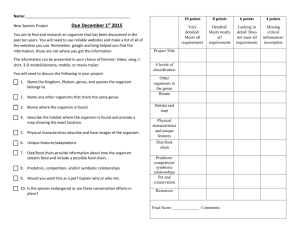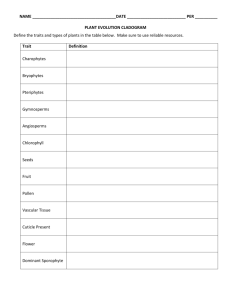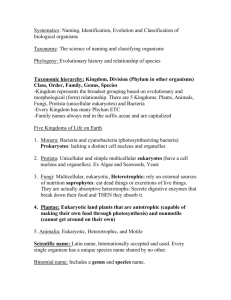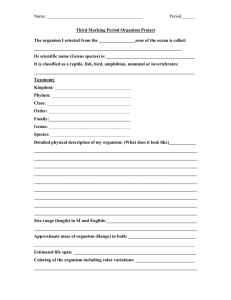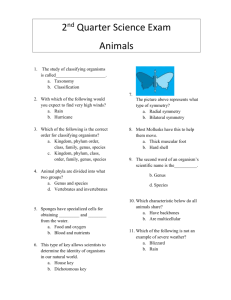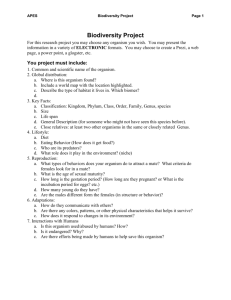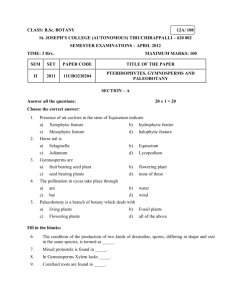quiz - classification - Queensland Science Teachers
advertisement
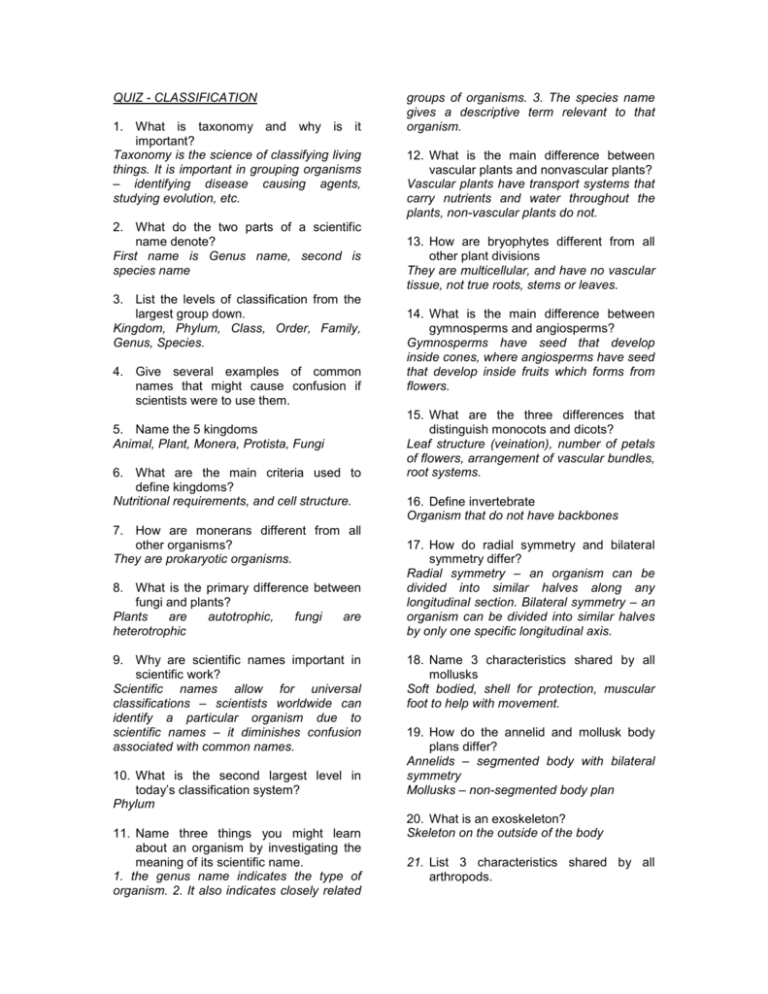
QUIZ - CLASSIFICATION 1. What is taxonomy and why is it important? Taxonomy is the science of classifying living things. It is important in grouping organisms – identifying disease causing agents, studying evolution, etc. 2. What do the two parts of a scientific name denote? First name is Genus name, second is species name 3. List the levels of classification from the largest group down. Kingdom, Phylum, Class, Order, Family, Genus, Species. 4. Give several examples of common names that might cause confusion if scientists were to use them. 5. Name the 5 kingdoms Animal, Plant, Monera, Protista, Fungi 6. What are the main criteria used to define kingdoms? Nutritional requirements, and cell structure. 7. How are monerans different from all other organisms? They are prokaryotic organisms. 8. What is the primary difference between fungi and plants? Plants are autotrophic, fungi are heterotrophic 9. Why are scientific names important in scientific work? Scientific names allow for universal classifications – scientists worldwide can identify a particular organism due to scientific names – it diminishes confusion associated with common names. 10. What is the second largest level in today’s classification system? Phylum 11. Name three things you might learn about an organism by investigating the meaning of its scientific name. 1. the genus name indicates the type of organism. 2. It also indicates closely related groups of organisms. 3. The species name gives a descriptive term relevant to that organism. 12. What is the main difference between vascular plants and nonvascular plants? Vascular plants have transport systems that carry nutrients and water throughout the plants, non-vascular plants do not. 13. How are bryophytes different from all other plant divisions They are multicellular, and have no vascular tissue, not true roots, stems or leaves. 14. What is the main difference between gymnosperms and angiosperms? Gymnosperms have seed that develop inside cones, where angiosperms have seed that develop inside fruits which forms from flowers. 15. What are the three differences that distinguish monocots and dicots? Leaf structure (veination), number of petals of flowers, arrangement of vascular bundles, root systems. 16. Define invertebrate Organism that do not have backbones 17. How do radial symmetry and bilateral symmetry differ? Radial symmetry – an organism can be divided into similar halves along any longitudinal section. Bilateral symmetry – an organism can be divided into similar halves by only one specific longitudinal axis. 18. Name 3 characteristics shared by all mollusks Soft bodied, shell for protection, muscular foot to help with movement. 19. How do the annelid and mollusk body plans differ? Annelids – segmented body with bilateral symmetry Mollusks – non-segmented body plan 20. What is an exoskeleton? Skeleton on the outside of the body 21. List 3 characteristics shared by all arthropods. Segmented body, jointed appendages, exoskeleton, bilateral symmetry. 22. What features distinguish insects from other arthropods? Antennae, 6 legs, 3 body segments. 23. Name and give examples of 3 chordate classes Class Aves (birds), Class Mammalia, Class Reptila, Class Amphibia 24. List four distinguishing features vertebrates Gill slits, notochord, dorsal cord, tail, of 25. Explain the difference between an autotrophic and heterotrophic cell and give examples of each type. Autotrophs produce their own food via photosynthesis or chemosynthesis. E.g. plants, algae etc. heterotrophs rely on other organism for nutrition and energy requirements. 26. Why do we need to classify living things? Eliminates confusion, universal naming system, identify dangerous organisms, etc. 27. Which have more features in common: members of the same kingdom, or members of the same species? Same species 28. The red iron bark tree is known scientifically as Eucalyptus sideroxylon. What is the red iron barks genus and species? Would you expect Eucalyptus sideroxylon and Eucalyptus viminalis to interbreed? Explain. Genus – Eucalyptus. Species – sideroxylon. No they would not interbreed as they are not members of the same species. 29. Cnadaria and molluscs are both soft bodied. How can you tell them apart? Cnidarias do not have full digestive cavity – only single opening. Molluscs have a full digestive cavity. 30. List the main features of chordates. Notochord, dorsal nerve cord, true body cavities, paired gill slits, backbone. 31. Name the 5 main groups of plants. What features have been used to classify plants into these groups? Algae – contain chlorophyll, simple aquatic organisms. Bryophytes - simple plants, no vascular tissue, no true roots stems or leaves. Pteridophytes – true roots stems leaves, no flowers or seeds. Gymnosperms – seeds inside cones. Angiosperms – seeds inside flowers (fruits). 32. What are tracheophytes? Name 2 examples. Tracheophytes are plants with true leaves, stems and roots. They are Pteridophytes, Gymnosperms, and Angiosperms. 33. a) b) a) How could you distinguish between a conifer and a flowering plant a liverwort and a fern conifers are gymnosperms therefore have seeds in cones, angiosperms have seeds in flowers. b) Liverworts are bryophytes therefore no true leaves stems or roots, ferns are Pteridophytes and have true leaves, stems and roots. 34. what characteristics would enable you to distinguish between a) A snake and an earthworm? b) A bird and a bat c) A platypus and a duck? a) snake is a reptile and a vertebrate, earthworms are annelids and are invertebrates. (reptiles are chordates, earthworms are annelids) b) birds are Aves – feathers covering body, bats are mammals, contain mammary glands have fur covering body. c) Platypus are mammals – monotremes have fur on body and mammary glands, Ducks are Aves – feathers covering body lay eggs. 35. Jellyfish are not really fish. To what phylum do the actually belong? Cnidaria .



